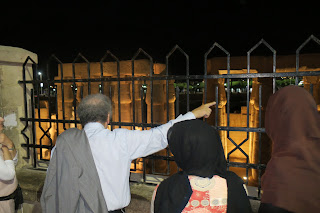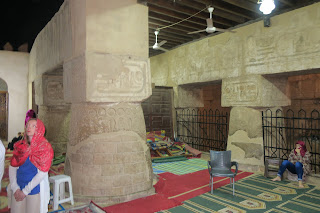The Mosque of Abu Haggag is a mosque located in the Egyptian city of Luxor.
Specifically, it stands atop the ruins of Luxor Temple, an Ancient Egyptian
centre of worship dating back to the reign of Pharaoh Amenhotep III in the
14th century BCE.
The mosque stands on the ancient columns themselves. That part of the Luxor
Temple was converted to a church by the Romans in 395 CE, and then to a mosque
in 640, more than 3400 years of continuous religious worship. Hence, the Luxor
Temple is the oldest building in the world at least partially active for other
than archeological or tourist purposes.
|
The mosque seen from Luxor Temple Square
The mosque, with its two minarets, is in the center of the photo. On the
right side of the photo we can see the first pylon of the Luxor Temple.
|
|
Arches in front of the mosque
The front of the mosque faces southeast.
- The front of the Luxor Temple faces northeast.
|
|
Side entrance to the mosque
|
|
On top of the mosque platform
The mosque is located on a platform. To access this platform we have to
climb a staircase. At the top of the staircase we leave our shoes.
-
From this platform we have a good view of the inside of the Luxor
Temple and Luxor Temple Square.
|
|
Interior of the mosque
In the center of the photo we can see the minbar, which is the raised
platform from which an imam (leader of prayer) addresses the
congregation, is located to the right of the modern mihrab.
|
|
Original mihrab
This mosque has two mihrab, one dating back to the original
construction, and a more modern one.
-
The mosque was built during the Ayyubid era, specifically around 1286
CE (658 AH).
- It was commissioned by As-Salih Ayyub.
|
|
Ancient Egyptian reliefs above the mihrab
The ancient Egyptian reliefs are protected by green glass.
-
In 2009, the mosque underwent restoration work. It took two years
under the supervision of the Supreme Council of Antiquities, and its
cost reached seven million Egyptian pounds. The new architecture
included expanding the prayer square, reinforcing the dome and
replacing the ceilings after the mosque was exposed to a fire in June
2007 and during restoration. During construction, columns and lintels
with ancient Egyptian inscriptions from the time of Pharaoh Ramses II
were discovered.
|
|
Ancient Egyptian columns inside the mosque
The mosque is built within the first court of the Luxor Temple complex.
-
This part of the temple was originally a court during the reign of
Pharaoh Ramesses II.
|
|
One of the two minarets of the mosque
The mosque has two minarets, made out of mud brick. The minarets are one
of the oldest components of the current mosque.
-
The older one consists of three floors; the first is square in shape,
the second and third are cylindrical, and at the top is a group of
windows and openings, and the square bottom part is reinforced with
wooden columns.
|
|
Northeast side courtyard
This side courtyard, between the mosque and the first pylon, features a
mix of ancient Egyptian and Islamic art.
-
This part of the Luxor Temple was converted to a basilica by the
Coptic Christians in 395 CE, and then to a mosque in 640 CE.
-
The site therefore has seen 3400 years of continuous religious use,
making the Luxor Temple the oldest building in the world at least
partially still in use, for purposes other than archeological or
tourist use.
|
|
Leaving Abu Haggag Mosque
|
See also
Source
Location





















